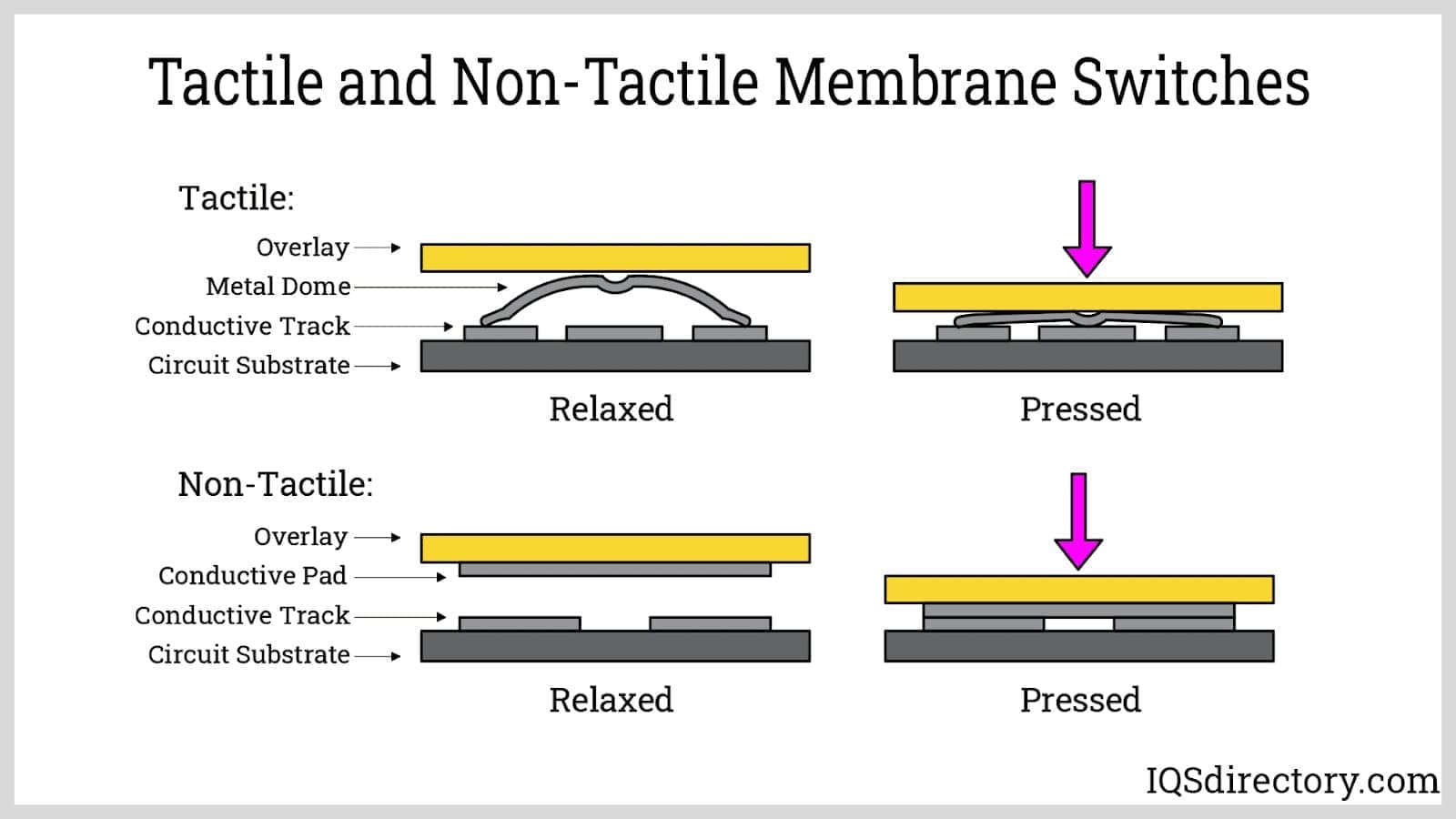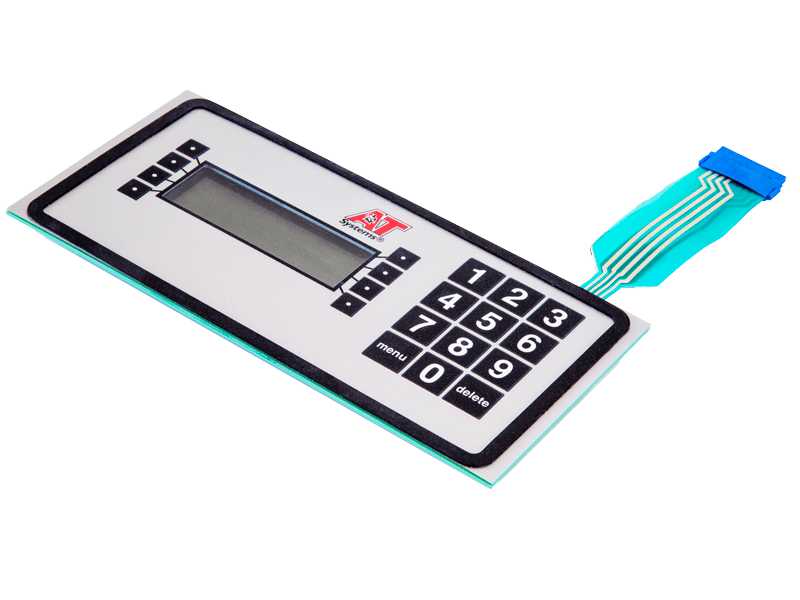Cutting-Edge Technology from a Expert Membrane Switch Manufacturer
Cutting-Edge Technology from a Expert Membrane Switch Manufacturer
Blog Article
Exactly How Membrane Switch Innovation Works and Its Function in Interface Style
Membrane button technology is an innovative approach that integrates split products for touch-sensitive input. Its design contains visuals overlays, conductive layers, and sticky components that engage when pressed. This communication not just finishes an electric circuit but likewise influences the overall user experience. Recognizing the intricacies of this innovation discloses its significant impact on individual interface design, prompting inquiries regarding its applications and future advancements in numerous markets.
Recognizing Membrane Switch Modern Technology
Membrane switch modern technology acts as an essential element in modern customer interface design. This innovation incorporates visuals overlays, touch-sensitive membranes, and circuit layers to produce a compact, dependable input approach for different tools. The design commonly consists of several layers, consisting of a published visuals layer that allows individuals to connect with the tool with responsive responses. Membrane switches are understood for their resilience, resistance to wetness, and convenience of cleansing, making them suitable for environments where conventional mechanical switches might fall short. Their inconspicuous layout makes it possible for seamless integration into devices, contributing to a smooth appearance. Additionally, Membrane switches can be personalized with numerous shades, structures, and signs, boosting customer experience and aesthetic charm. This flexibility makes them preferred in customer electronic devices, clinical gadgets, and commercial controls, where intuitive communication is essential. In general, Membrane button technology represents a considerable improvement in exactly how individuals engage with electronic user interfaces.
Trick Elements of Membrane Changes
Membrane switches include numerous crucial components that add to their capability and layout. The conductive layer materials, adhesive and assistance layers, and visuals overlay style each play a vital duty in making certain suitable performance and user communication. Comprehending these components is essential for reliable individual interface design.
Conductive Layer Products
Conductive layer materials play an important function in the functionality and integrity of Membrane buttons. When pressure is used to the switch, these products are responsible for finishing electrical circuits. Typically, a mix of conductive inks, such as silver or carbon, is utilized to produce these layers. Silver conductive ink is favored for its premium conductivity and sturdiness, while carbon ink is often made use of for affordable applications. The selection of material impacts not only the electrical efficiency but likewise the overall life expectancy of the button. Furthermore, the density and composition of conductive layers can affect tactile comments and button actuation. Selecting the proper conductive product is important for making certain excellent performance in varied interface applications.
Sticky and Support Layers
Sticky and assistance layers are essential elements that add to the structural honesty and functionality of Membrane buttons. These layers give a robust foundation, making sure that the numerous elements of the Membrane switch stay safely adhered and properly aligned throughout their operational life. The sticky layer promotes the add-on of the button to the underlying surface, providing toughness versus ecological factors such as moisture, temperature variations, and mechanical anxiety. Assistance layers boost the button's strength, stopping contortion during use and contributing to a constant tactile reaction. Together, these components play a vital duty in keeping the efficiency and durability of Membrane switches, ultimately affecting the total customer experience in user interface style.
Graphic Overlay Design
Typically neglected, graphic overlay layout plays a necessary role in the functionality and appearances of Membrane buttons. This style mainly serves as the user interface in between the user and the electronic devices, supplying both visual allure and functional clarity. Reliable visuals overlays utilize shade, typography, and icons to guide customers in navigating controls and understanding device features. Additionally, the choice of products impacts longevity and responsive feedback, ensuring the overlay stands up to wear while maintaining a pleasurable user experience. In addition, specific placement of the overlay with the underlying components is crucial for ideal efficiency. Finally, thoughtful graphic overlay style boosts usability, adds to brand name identity, and ultimately affects customer fulfillment in tools utilizing Membrane switch modern technology.
The Production Process of Membrane Changes
The production process of Membrane changes includes numerous critical steps that guarantee performance and longevity. Initially, a graphic overlay is created, incorporating individual interface elements and branding. This overlay is published onto a flexible substrate, normally polyester or polycarbonate, making use of accuracy printing strategies to identify quality and shade accuracy.Next, adhesive layers are used, adhered to by the assimilation of conductive traces, often made from silver or carbon, which are important for electrical connectivity. These traces are screen-printed or etched onto a separate layer. After this, a spacer layer is included in develop the essential void in between the circuit and the overlay layer, permitting tactile comments when activated.Finally, the components are assembled and tested for quality guarantee, ensuring that each Membrane switch fulfills the required specs for performance and integrity. This thorough procedure leads to a robust product suited for numerous applications in individual interface style.
Advantages of Making Use Of Membrane Changes

Membrane switches over offer countless benefits that make them a preferred option in individual interface layout. One substantial advantage is their compact and light-weight nature, enabling streamlined designs in numerous applications. Additionally, Membrane buttons give a sealed interface, shielding against dust, dampness, and contaminants, which enhances toughness and reliability. They are additionally highly customizable, allowing developers to develop unique graphics and designs customized to specific user needs.Another benefit is their cost-effectiveness, as they commonly need much less material and labor compared to typical switches. The tactile responses of Membrane buttons can be crafted to boost user experience, using a satisfying reaction without the mass of mechanical parts. Membrane switches can be easily integrated into diverse atmospheres, such as clinical tools, commercial tools, and consumer electronics. In general, these advantages highlight the growing popularity of Membrane switches in contemporary interface style.
Applications in Numerous Industries
Extensively made use of throughout numerous sectors, Membrane button modern technology has actually located its area in applications varying from clinical gadgets to consumer electronics. In the health care industry, these switches are essential to gadgets such as analysis devices and individual tracking systems, using durable, easy-to-clean user interfaces that stand up to sanitation processes. The automobile market employs Membrane buttons in dashboards and control panels, supplying trusted procedure in challenging environments.Consumer electronics, consisting of home devices and gaming consoles, gain from the smooth style and customizability of Membrane switches, boosting customer interaction. Additionally, commercial equipment utilizes these switches for control board, making certain resistance to dirt and moisture while preserving functionality.Moreover, the aerospace and armed forces industries use Membrane switches for sturdy applications, where integrity and performance are crucial. Generally, Membrane switch modern technology offers diverse sectors by integrating capability, toughness, and aesthetic appeal, making it a functional choice for modern-day interface.

Creating Interface With Membrane Switches
When creating customer interfaces with Membrane switches, careful factor to consider of both capability and aesthetics is crucial. Membrane switches offer a sleek, inconspicuous design that can boost visual charm while maintaining functionality. Designers need to focus on switch layout, making sure user-friendly placement for ease of procedure. The responsive comments offered by the Membrane button is essential; it can affect user fulfillment and total experience.Additionally, shade and graphic aspects ought to align with the brand identity, strengthening recognition and familiarity. Selecting resilient products that withstand deterioration is likewise vital, as long life adds to usability over time. Incorporating backlighting can enhance visibility in numerous illumination problems, additionally boosting user interaction. Eventually, a well-designed Membrane switch user interface balances both kind and function, ensuring that the customer experience is both efficient and engaging, meeting the demands of diverse applications across sectors.
Future Patterns in Membrane Switch Technology
As Membrane button technology progresses, the combination of wise functionalities is becoming progressively famous. These innovations enable improved interactivity and connection within user interfaces (membrane switch manufacturer). browse this site Additionally, the change towards green products mirrors a growing commitment to sustainability in layout methods
Smart Membrane Switches Over

Eco-Friendly Products Use
In the middle of the improvements in Membrane switch innovation, a considerable trend is emerging in the direction of using environment-friendly products. Producers are progressively focusing on sustainability by incorporating naturally degradable plastics and safe inks, minimizing environmental impact. This change not just aligns with global ecological requirements yet also addresses customer need for greener items. Innovations in material science have allowed the development of durable, environmentally friendly options go to this website that maintain performance without jeopardizing quality. These products supply equivalent performance to typical choices while reducing waste and poisoning. As markets become extra eco-conscious, the combination of sustainable techniques in Membrane switch manufacturing is anticipated to increase, strengthening a commitment to ecological responsibility and leading the way for more lasting individual interface solutions in the future.
Often Asked Questions
How Do Membrane Changes Differ From Conventional Mechanical Buttons?
Membrane switches over vary from conventional mechanical buttons mostly in building and construction and operation. They utilize flexible layers that develop a sealed interface, whereas mechanical buttons rely on physical activity and contact, resulting in distinctive sturdiness and responsive feedback characteristics.
Can Membrane Switches Over Be Personalized for Specific Applications?
Membrane switches can undoubtedly be personalized for certain applications - membrane switch manufacturer. Suppliers develop them to fulfill distinct requirements, enabling tailored layouts, graphics, and performances that improve customer interaction and fit certain operational demands successfully
What Is the Lifespan of a Membrane Switch?
The life-span of a membrane button typically ranges from 1 to 5 million actuations, relying on factors such as material high quality, ecological conditions, and usage regularity. Regular testing can help identify its long life and reliability in applications.
Are Membrane Changes Water Resistant or Immune to Chemicals?
Membrane switches can be developed to be immune and waterproof to chemicals, depending on the materials utilized and making procedures. Correct sealing and protective finishings improve their longevity in various environmental conditions and applications.
How Do Membrane Switches Impact Device Energy Consumption?
Membrane switches can significantly impact gadget energy consumption by guaranteeing effective operation. Their low power demands during activation help reduce energy usage, contributing to longer battery life and overall better effectiveness in digital tools. Membrane switches are understood for their durability, resistance to wetness, and simplicity of cleansing, making them appropriate for atmospheres where standard mechanical switches may fail. The automotive sector uses Membrane switches in Your Domain Name dashboards and control panels, giving reliable procedure in challenging environments.Consumer electronic devices, including home appliances and pc gaming consoles, advantage from the sleek design and customizability of Membrane buttons, improving user communication. In addition, industrial machinery makes use of these switches for control panels, ensuring resistance to dirt and wetness while preserving functionality.Moreover, the aerospace and military fields use Membrane buttons for rugged applications, where integrity and efficiency are crucial. The evolution of Membrane switch modern technology is going into an exciting phase with the appearance of wise Membrane switches, which incorporate innovative attributes and capabilities. Membrane changes vary from standard mechanical buttons largely in construction and operation.
Report this page